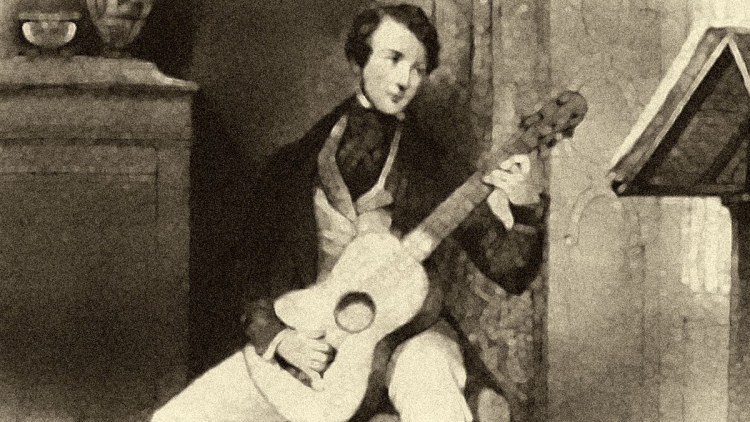Biography
Italian classical guitarist Matteo Carcassi was born in Florence in 1792 and died in Paris in 1853. He moved to Germany in 1810, but moved to Paris in 1815 where he lived most of his life.
Carcassi made a living as a touring concert guitarist. He performed in prestigious concert halls, and often went on concert tours around Europe. In Paris, he met friend and fellow guitarist Jean-Antoine Meissonnier, who published many of Carcassi’s works.
Despite his virtuosity, some believe Carcassi may have been overshadowed by his prolific contemporary guitar composer, Ferdinando Carulli.
Nevertheless, Carcassi did receive recognition in his lifetime, and his music prevailed as an extremely valuable and important asset to classical guitar pedagogy.

Matteo Carcassi Guitar Method
Many people wonder: did Matteo Carcassi have a guitar method? The answer is yes! Carcassi’s Op.59 is a complete method book and his Op.60 is a well-known collection of etudes.
Carcassi’s Op.59, Methode Complete – Divisee en trois parties (Complete Method. Divided in Three Parts) and Op.60, 25 Etudes Melodiques et Progressives (25 Melodic and Progressive Studies) are popular resources still in wide circulation today.
Carcassi’s Op.60, 25 Melodic and Progressive Studies is a set of etudes that blend technical exercises with romantic melodic themes.
This collection of etudes is essential for guitarists moving from the beginner, to intermediate, and even advanced stages.
You can download editions of both using the links above, or you can buy Matteo Carcassi’s Guitar Method here:
Classical guitar students worldwide are familiar with this collection of etudes, each of which offers a mix of technical brilliance and beautiful melodic phrases.
Examples of Carcassi’s Op.60, 25 Melodic and Progressive Studies
You can hear several of my favorite Carcassi’s Op.60 etudes on my 2020 album 20 Classical Guitar Etudes for Beginner and Intermediate Students:
Op.60, No.1
Etude No. 1, Op. 60: Allegro
Sheet Music: Etude No.1, Op. 60: Allegro
Carcassi’s Etude No.1 is a great exercise for practicing various scales. That being said, it also includes interesting melodies and harmonies. Speed, accuracy, and articulation are the important skills to work on in this intermediate study.
Op.60, No.3
Carcassi’s Op.60, Etude No.3 (Andantino) is an excellent early intermediate classical guitar etude with a beautiful arpeggio pattern and clear melody in the key of A major.
This study has an A section and B section, both of which repeat. Many of the chord shapes you encounter in the A section appear in the B section, but the B section is substantially longer and includes phrases in the 7th and 9th positions.
The B section kicks off with a dramatic build up, and modulates to the key of F# major. Half way through, the piece returns to the original key of A major on a variation of the familiar theme from the A section.
Overall, Carcassi’s Op.60, Etude No.3 is one of the best upper beginner/early intermediate etudes for learning how to play upper position notes in the key of A major. You’ll also learn how to bring out a clear melody in the upper voice over a consistent arpeggio pattern (p-i-m-a-i-m-a-i-m-p-i-m).
Op.60, No.2
Etude No. 2, Op. 60: Moderato Expressivo
Matteo Carcassi’s Etude No.2, Op.60 Moderate Expressivo is one my favorite intermediate classical guitar studies to give to students wishing to learn the classical tremolo technique (p-a-m-i). Although it doesn’t strictly follow the tremolo pattern (I use p-i-m-a-m-i-m-a for this one), the right had mechanics are similar.
Note: A common alternative fingering for this piece is (p-i-m-a-m-a-m-a), which is also effective for practicing m-a independence.
Regardless of which pattern you choose, this guitar etude is a terrific opportunity to focus on right hand tonal consistency. The melody of Carcassi’s Etude No.2 is both beautiful and dramatic right away.
This is also a terrific study for learning to read and play common chord shapes higher up the neck. Getting the right hand pattern consistent and memorizing the chord shapes is one thing, but paying close attention to the dynamics and playing this piece “con expressivo” takes a lot of practice and control.
Op.60, No.6
Carcassi’s Op.60 Etude No.6 starts off in the key of C major, common time. The piece starts off with two distinct voices: a bold, steady bass line and a simpler contrasting melody line.
Right off the bat, these first 8 measures, which repeat, are a workout for the right hand thumb! At the same time, your left hand has to move smartly and swiftly to land on all the right notes.
Following the intro section, Carcassi goes to the key of G major with the bold melodic line now happening on the higher strings. Your right hand i-m and a fingers have their work cut out for them for the remainder of the piece, and all the while you must carefully balance this melody with the bass line.
This middle section also has several “Scarlatti-like” phrases where the bass and melody line play at the simultaneously on each 8th note beat–an exciting way to lead into cadences. Carcassi takes us back to the key of C major and introduces a fun and dramatic call-and-response phrase that repeats. Key changes are frequent in this part of the piece.
However, Carcassi concludes the piece with a series of mellow phrases with frequent B flats that imply a modulation to the key of F major. Carcassi’s ability to make the I chord of the original key (C major) become the V chord at the end of the piece (F major) is subtle, elegant, and genius. Carcassi morphs things once again with an interplay between B°7 and C major chords. After a final dramatic F minor chord, he ends the piece with a bright C major chord.
Op.60, No.7
Etude No.7 is probably the most popular from Carcassi’s Op.60 collection. Thist piece is fast, intense, and beautiful!
The phrases that include the recurring p-a-m-i are brief, this study is a superb introduction to the tremolo technique. This brilliant etude is suitable for the intermediate level.
Op.60, No.14
Matteo Carcassi’s Op.60 Etude No.14 is a fun, fast, and lively classical guitar study mostly in the key of D major. This is a great intermediate guitar etude for students who are: getting more comfortable with D major positions, learning to read notes higher on the fret board, i-m string crossing, and working on building up speed.
Although this study is not as difficult as others in the collection, it’s still full of tricky passages! The piece is almost one long single line melodic solo, but with some bass harmony thrown in (usually on the downbeat of each measure with the exception of a couple bass melodic passages in the middle of the piece).
The subtlety of this bass line is important, and serves as a nice counteraction with the upper melody voice. Additionally, maintaining a balanced tone with the right hand as you switch between strings at breakneck speed can also be challenging.
Is Carcassi No.14 largely just a scale-based piece? You could certainly argue that it is, but with some interesting twists and turns. Overall, this is a terrific classical guitar study with a nice melodic line. Furthermore, Op.60 No.14 sounds great at various speeds–something you’ll get all too familiar with if you work on this etude long enough to bring it up to the “moderate allegro” speed as indicated on the score!
You can get the full sheet music for Carcassi’s Op.60, 25 Melodic and Progressive Studies here.

